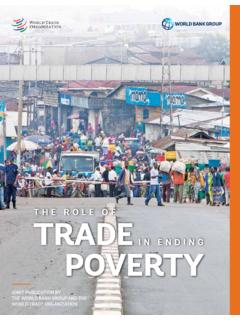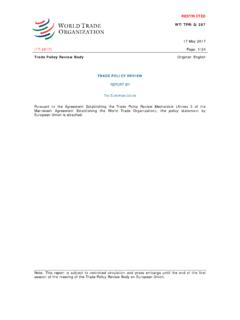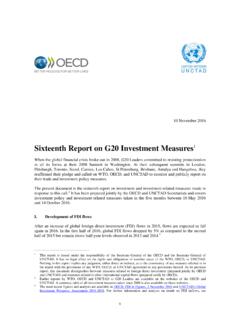Transcription of CHAPTER 5 ECONOMIC DIVERSIFICATION: LESSONS FROM …
1 135 CHAPTER 5 ECONOMIC DIVERSIFICATION: LESSONS FROM PRACTICEC ontributed by the world Bank Group1 Abstract: ECONOMIC diversification remains a challenge for most developing countries and is arguably greatest for countries with the lowest incomes as well as for those whose economies are small , landlocked and/or dominated by primary commodity dependence. For such countries, ECONOMIC diversification is inextricably linked with the structural transformation of their economies and the achievement of higher levels of productivity resulting from the movement of ECONOMIC resources within and between ECONOMIC sectors. Rooted in examples of world Bank Group support, this CHAPTER traces the boundaries of any discussion of ECONOMIC diversification by advancing a definition that encompasses two related dimensions of diversification: (i) trade diversification ( exporting new or better products, or to new markets) and (ii) domestic production diversification ( cross-sectoral rebalancing of output, driving the reallocation of resources across industries and within industries between firms to increase total factor productivity).
2 The CHAPTER raises awareness on the complexity of the diversification process and the state of knowledge surrounding ECONOMIC diversification. While the current global environment creates challenges for poor, small , landlocked and/or resource-dependent countries, a range of new diversification routes can be followed. This however requires that policy attention be paid to four key determinants of successful diversification strategies, which development partners and International Organisations can support through targeted Aid for trade interventions. These are: (i) the supply of appropriate incentive frameworks; (ii) investments and policy reforms targeted at reducing trade costs; (iii) effective policies to support adjustment and the reallocation of resources towards new activities; and (iv) government interventions directed at specific market, policy and institutional failures.
3 AID FOR trade AT A GLANCE 2019: ECONOMIC DIVERSIFICATION AND EMPOWERMENT - OECD, WTO 201913 6 CHAPTER 5. ECONOMIC DIVERSIFICATION: LESSONS FROM PRACTICE WHY ECONOMIC DIVERSIFICATION MATTERS ECONOMIC diversification is a key element of ECONOMIC development in which a country moves to a more diverse pro-duction and trade structure. A lack of ECONOMIC diversification is often associated with increased vulnerability to external shocks that can undermine prospects for longer-term ECONOMIC growth. The world s poorest countries, many of which are often small or geographically remote, landlocked and/or heavily dependent on primary agriculture or minerals, tend to have the most concentrated ECONOMIC structures. This creates challenges in terms of exposure to sector-specific shocks, such as weather-related events in agriculture or sudden price shocks for minerals. Figure Export diversification in Sub-Sharan Africa, AfricaNamibiaMozambiqueKenyaTanzaniaSene galMadagascarTogoUgandaBeninSierra LeoneRwandaMauritaniaLesothoC te d'IvoireSomaliaCongo, Dem.
4 GuineaMaliCongo, FasoBotswanaAngolaGuinea-BisseauChadSout h SudanSCALE 0-1 Source: Authors calculations. 12 AID FOR trade AT A GLANCE 2019: ECONOMIC DIVERSIFICATION AND EMPOWERMENT - OECD, WTO 2019137 CHAPTER 5. ECONOMIC DIVERSIFICATION: LESSONS FROM PRACTICE Growth also tends to be unbalanced in the case of mineral dependent countries or slow and difficult to sustain in agrarian ones. Poverty-reducing, trade -driven, growth has been particularly difficult to achieve in countries whose economies are heavily dependent upon primary commodities. Countries whose geography implies a punishing lack of connectivity to regional or world markets are also at a distinct disadvantage in attempting to diversify their product and export mix. Figures and offer a snapshot of diversification levels across regions of the developing world , using Herfindhal-Hirschman indices of market Figure Export diversification in selected developing country regions, 2017 (Continued on following page)SCALE LankaIndiaNepalPakistanAfghanistanBangla deshMaldivesBhutanExport diversification (HHI) - South Asia, 2017 SCALE keyHungaryBosniaBulgariaUkraineBelarusAl baniaMoldovaMacedoniaGeorgiaTajikistanRu ssiaKyrgyz k m enis t anAzerbaijanExport diversification (HHI) - East and Central Europe, 2017 AID FOR trade AT A GLANCE 2019: ECONOMIC DIVERSIFICATION AND EMPOWERMENT - OECD, WTO 2019138 CHAPTER 5.
5 ECONOMIC DIVERSIFICATION: LESSONS FROM PRACTICE Figure Export diversification in selected developing country regions, 2017 (Continued from previous page)SCALE 1 ThailandIndonesiaChinaCambodiaVietnamMya nmarKorea, v aluPhilippinesLao PDRS amoaTongaVanuatuMongoliaSolomon IslandsKiribatiPalauMicronesiaExport diversification (HHI) - East Asia Pacific, 2017 SCALE 1 TunisiaMoroccoLebanonJordanSyriaEgyptDji boutiBahrainUnited Arab EmiratesAlgeriaQatarYemanOmanSaudi ArabiaIranLibyaIraqExport diversification (HHI) - Middle East and North Africa, 2017 AID FOR trade AT A GLANCE 2019: ECONOMIC DIVERSIFICATION AND EMPOWERMENT - OECD, WTO 2019139 CHAPTER 5. ECONOMIC DIVERSIFICATION: LESSONS FROM PRACTICE Figure Export diversification in selected developing country regions, 2017 (Continued from previous page)SCALE 1 MexicoEl SalvadorGuatemala Argentina BrazilHondurasNicaraguaPanamaDominican RepublicCosta RicaUruguayBarbadosChilePeruDominicaBeli zeColombiaHaitiBahamas, TheTrinidad and TobagoArubaBoliviaCubaEcuadorAntigua and BarbudaJamaicaGuyanaSurinameVenezuelaExp ort diversification (HHI) - Latin America and Caribbean, 2017 Source: Authors helps to manage volatility and provide a more stable path for equitable growth and development .
6 Successful diversification is all the more important now in the wake of slowing global growth and the imperative in many developing countries to increase the number and quality of jobs. trade expansion is central to creating new, higher productivity, jobs that will facilitate growth through structural transformation. Moving labour from low produc-tivity employment, mainly in agriculture, to higher productivity jobs in a range of mostly urban activities characterised by strong agglomeration economies is imperative for sustained growth. Countries in East Asia made such a growth transition in the 1990 s through reliance on exports of labour-intensive manufactures. The challenge today for many developing countries is not only to grow labour-intensive manufacturing, but also value-adding agri-business, horti-culture, and selected services, activities that are all at once labour-intensive, tradable and value-adding.
7 While rapid increases in working populations offer many developing countries an opportunity for a demographic dividend, reaping it may remain challenging in the absence of ECONOMIC diversification and job-producing private sector growth. The need for government action through well designed public investments and effective policy reforms that support a more diversified economy remains centrally important. 12 AID FOR trade AT A GLANCE 2019: ECONOMIC DIVERSIFICATION AND EMPOWERMENT - OECD, WTO 201914 0 CHAPTER 5. ECONOMIC DIVERSIFICATION: LESSONS FROM PRACTICE ECONOMIC diversification and structural transformation the movement of factors of production within and across different sectors towards higher productivity uses - are closely linked phenomena. Structural transformation can refer to the shift from agricultural to non-agricultural sectors, or from manufacturing to services.
8 A broad and well documented trend has been the gradual decline in the importance of agriculture accompanied by an initial increase followed by decline in manufactures and a corresponding increase in services that consistently shows across many countries as a part of the process of ECONOMIC development (Herrendorf, Rogerson and Valentinyi, 2014). Such a trend is perhaps most visible in global labour markets. The share of agriculture in total employment has been shrinking across all country income groups. Globally, it has con-tracted by close to a third, from 44 per cent in 1991 to 28 per cent in 2018, with the largest contribution attributable to middle-income countries (see Figure ).3 The share of employment in manufacturing has also been decreasing globally and is down slightly from 16 percent in 1991 to 14 percent in 2018, a trend driven primarily by high-income countries, where advanced robotics and the adoption of other labour-saving technologies has made the greatest headway ( world Bank, 2017).
9 The sectors in which the most significant employment expansion has occurred in recent decades all relate to services, with construction, non-market (public) services and, most importantly, a host of market services leading the way (ILO, 2019). Figure Distribution of employment by aggregate sectors, global and country income groupings, 1991 and 2018 (percentages)SHARE IN EMPLOYMENT (PERCENT)AgricultureMarket servicesNon-market servicesConstructionManufacturingMining and quarrying: Utilities020406080100201819 91201819 91201819 91201819 91201819 91 High incomeUpper-middle incomeLower-middle incomeLow incomeWorldSource: ILO (2019)Efforts at ECONOMIC diversification could be made more daunting if new technologies and automation encourage a reshoring of manufacturing production to developed economies. However technological change and globalisation are also generating new opportunities for resources to shift within agriculture to higher productivity activities, and services as well as manufacturing can drive diversification and structural transformation (Hallward Driemeir and Nayaar, 2017).
10 The recent years has seen countries at all levels of development witness a significant expansion of the role of services in their economies, with technological change a prime driver of what has come to be called the servicification of the world economy (National Board of trade , 2010). AID FOR trade AT A GLANCE 2019: ECONOMIC DIVERSIFICATION AND EMPOWERMENT - OECD, WTO 2019141 CHAPTER 5. ECONOMIC DIVERSIFICATION: LESSONS FROM PRACTICE Technological innovations in services such as mobile communications and associated value-added services (e-commerce, e-payments), access to cloud computing and data storage are rapidly changing the very economics of services delivery and the geography of trade and investment in the sector. In the future, Baldwin (2018) describes virtual presence technology and instant machine translation that could enable talented foreigners sitting abroad to provide services in offices and workspaces based in other countries.










